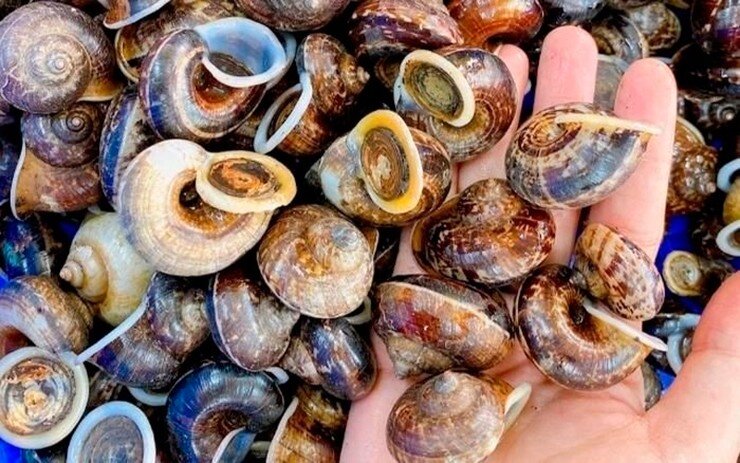Hòa Bình Rock Snails, also known as mountain snails or medicinal snails, are a unique species native only to limestone environments, mountain caves, and small streams in the forest. They are elusive and rarely seen as they remain hidden during the dry season, emerging only when the humidity is high enough. These snails move slowly and are almost invisible in the darkness, requiring keen eyes and a strong flashlight to spot them.

The value of Hòa Bình Rock Snails lies not in their appearance, with their dark brown, round, and flat shells resembling coins, but in their unique dietary habits. These mountain snails primarily absorb nutrients from forest leaves, including various medicinal herbs known only to the locals. As a result, their meat has a sweet and delicate flavor with a crunchy texture and a subtle hint of herbs. According to the beliefs of the Thai and Mường people, the “tail” of the snail, which contains its intestines, is considered a natural pouch that accumulates the essence of the mountains and forests. Therefore, it is a longstanding tradition to “eat the snail with its intestines” to fully appreciate its nutritional value.
According to experienced forestgoers, these snails are mainly found in mountainous districts such as Mai Châu, Tân Lạc, Kim Bôi, Lạc Sơn, and a part of Lạc Thủy. These areas, with their limestone terrain and rich vegetation, provide the ideal habitat for the snails due to high humidity levels. The locals believe that the abundance of snails is a sign of a healthy and thriving forest ecosystem. Conversely, when the forest suffers from degradation and the vegetation is affected, the precious food source dwindles, and the snails gradually disappear.

In well-known community tourism sites such as Lác and Chiềng Châu (Mai Châu), steamed mountain snails with lemongrass have become a traditional welcome dish for visitors. The snails are steamed with lemongrass, ginger, lime leaves, and wild chili peppers, creating an aromatic and pure flavor profile. When savored, the snails offer a sweet and crunchy taste with a subtle hint of bitterness, a unique flavor that can only be found in the forests.
For decades, Hòa Bình Rock Snails have been a humble delicacy, gracing the tables of the Mường and Thai people during the rainy season or as a silent pride in their hospitality. Today, with the growth of tourism and market demands, these snails have become a sought-after specialty. They are featured on the menus of restaurants in Hòa Bình city, Kim Bôi, and community tourism sites, receiving high praise from many visitors.

Once a seasonal dish, Hòa Bình Rock Snails have now become an important source of livelihood for many mountain families. Requiring no investment or laborious care, locals only need keen eyes and sturdy legs to venture into the forests. At the start of the season, prices can reach up to 90,000 VND per kg, enabling diligent collectors to earn between 5 and 7 million VND per month. Through social media and traders, these snails have made their way to the lowlands and big cities, becoming a promising economic product.
However, the negative impacts of this development are becoming increasingly apparent. As the snails gain popularity as a “specialty” and a “commodity,” the intensity of exploitation has exceeded self-sufficiency levels. In the past, locals could find snails by simply walking around their villages, but now they have to trek for kilometers and climb higher into the mountains. Collectors no longer selectively pick larger snails but gather even the smaller, immature ones. Excessive exploitation methods, such as overturning rocks and digging through layers of leaves with high-powered lights, disrupt the natural habitat of these snails.

Consequently, the natural population of these snails is declining. Areas that once yielded dozens of kilograms of snails per night now barely produce a few kilograms. Another concerning fact is that Hòa Bình Rock Snails have not yet been included in the list of protected species, and there are no specific regulations regarding harvesting seasons, minimum size restrictions, or protected hunting areas. While local authorities recognize the threat, they face challenges in managing and controlling the situation.
The question arises: How long can a livelihood that relies entirely on nature and uncontrolled exploitation be sustained? As the snails transform from a cultural delicacy to a commodity to be “depleted,” the most pressing question is what can be done to conserve this species and maintain a sustainable livelihood for the local community?
The answer lies not only in regulating exploitation but also in raising awareness and changing mindsets. Protecting the forest means protecting the snails, and protecting the snails means preserving a piece of the soul in the meals of the Mường and Thai people, retaining a dish with medicinal properties, and safeguarding a quiet yet enduring means of subsistence for countless households in the shadow of the mountains.






























